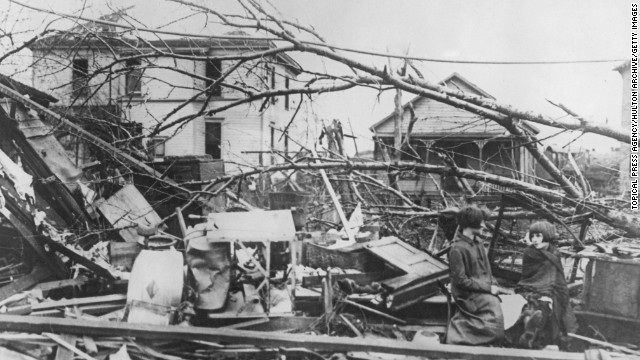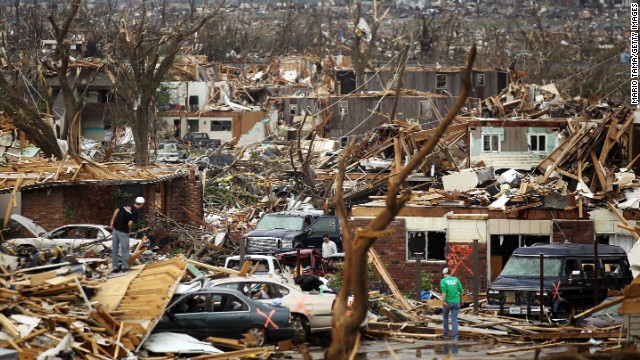Storms tore a deadly path through at least three counties in Arkansas on
Sunday evening and ripped houses, cars and forests to shreds, strewing
rubble for miles.
 |
| The "Tri-State Tornado," which killed 695 people and injured 2,027, was the deadliest tornado in U.S. history, according to the National Oceanic and Atmospheric Administration. The tornado traveled more than 300 miles through Missouri, Illinois and Indiana on March 18, 1925, and was rated an F5, the most powerful under old Fujita scale (winds of 260-plus mph). |
Though it's not yet official, weather forecasters strongly suspect tornadoes are to blame for at least 14 deaths and devastating damage in the state. Two more people died in storms on Iowa and Oklahoma.
A tornado's shearing,
twisting winds can exceed 300 mph, and though they usually last only
seconds, some cyclones endure much longer, razing swaths up to a mile
wide that scar landscapes for months to come and inflict tragic human
losses.
 |
| The tornado that struck Joplin, Missouri, on May 22, 2011, killed 158 people and injured more than 1,000. The storm packed winds in excess of 200 mph and was on the ground for more than 22 miles. |
The United States has the
highest number of tornado occurrences in the world, with an average of
1,200 tornadoes reported each year, according to the National Weather Service.
Arkansas winds 'severe'
Meteorologists rank a tornado based on the strength of its winds and the area over which it spreads destruction.
The Enhanced Fujita Scale assigns tornadoes corresponding numbers from EF0, with gusts from 65 to 85 mph, to the mightiest EF5, with gusts over 200 mph.
The EF0's winds are
described as "gale" winds; those of the EF5 are called "incredible." The
figures for tornadoes' wind speeds are based on assessments of the
damage they leave behind on the ground.
Only 59 EF5 storms have hit the United States since 1950, according to weather service records. The latest one devastated Moore, Oklahoma, in May of last year.
Though meteorologists
have not finished analyzing the most recent Arkansas storm, so far the
state has been spared an EF5, the NWS says.
CNN meteorologist Chad
Myers estimates that the winds that ravaged the town of Mayflower,
Arkansas, on Sunday had speeds of 130 to 150 mph, which would correspond
to an EF3 tornado, which the Fujita Scale describes as "severe."
Let's take a look at the nature of the strongest tornadoes, the EF5s, the strongest storms on Earth.
Where do storms of this strength most commonly hit?
While EF5 storms are
rare, the area in the Great Plains known as "Tornado Alley" gets more
than its share. The alley runs through Texas, Oklahoma, Kansas and Iowa.
There also seems to be a focus for strong tornadoes in an area known as
"Dixie Alley," which covers parts of the Southeast and includes
Mississippi, Tennessee, Alabama and Georgia.
What factors give rise to a storm of this strength?
A number of factors have
to come together at the right time and place to produce a strong
tornado. The clash of warm and cold air at the surface combined with
lift in the atmosphere and strong winds, both at the ground and high
above, help contribute. The greater the temperature differences and the
winds, the greater the chance for supercells, the thunderstorms that
produce tornadoes.
How long does it take to assess the strength of a storm? Why does it take so long?
After a tornado, the
local National Weather Service office sends a team to take a look at the
damage. In the case of the monster twister in Moore last year, the
Norman, Oklahoma, office sent numerous teams into the field to evaluate
damage. Since this storm path was 17 miles long and the damage path was
so wide, it took time to see all of the damage.
The strongest tornado on
record to date struck Moore in 1999. It had winds recorded at 318 mph
at 300 feet above the Earth's surface. Officials estimated winds at the
surface were at 250 mph.
No comments:
Post a Comment